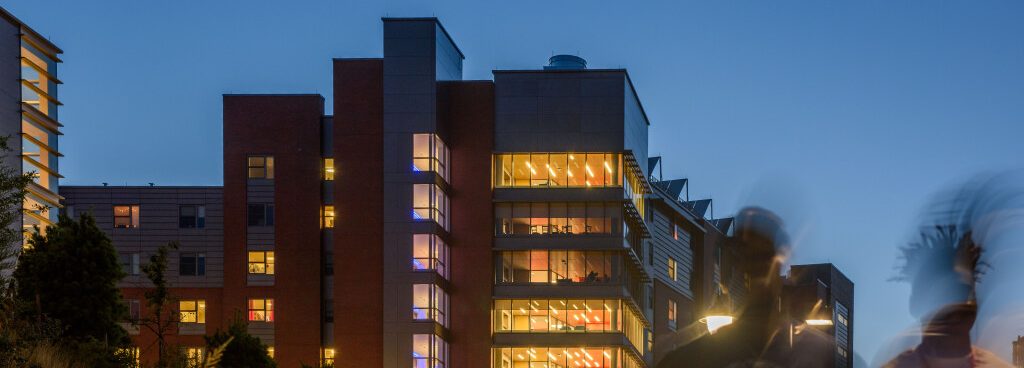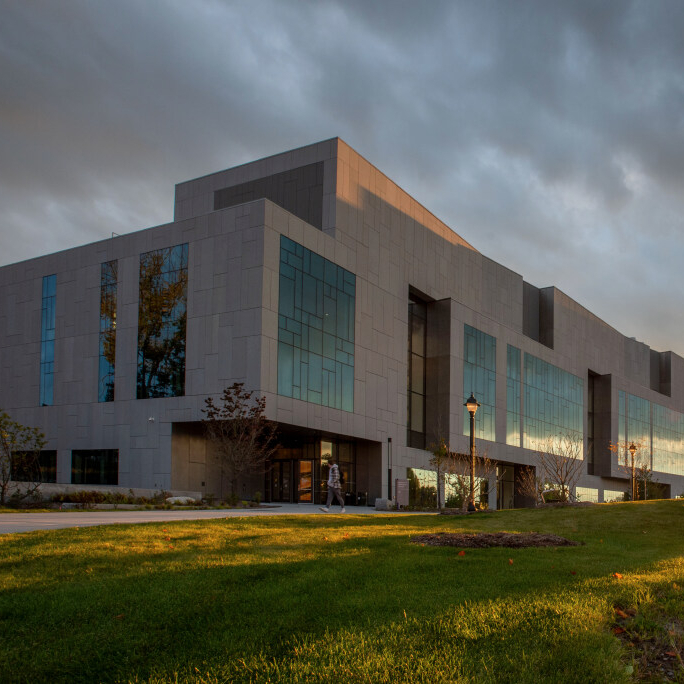
Buildings
Sustainability in building design, construction, maintenance, and efficiency
The University of Connecticut is committed to further sustainability goals in building design and construction. In 2016, the University adopted the Sustainable Design and Construction Policy that mandates the University plan, design, construct, renovate, and maintain sustainable, energy and water-efficiency buildings. By that standard, all new construction projects at UConn estimated at greater than $5 million must pursue at least a LEED Gold Rating. Read more below about LEED buildings at UConn and other sustainable building operations.
LEED Buildings at UConn

The U.S. Green Building Council's LEED (Leadership in Energy and Environmental Design) rating system is the preeminent program for the design, construction, maintenance, and operation of high-performance sustainable buildings. Projects pursuing LEED certification earn points for various green building strategies across several categories: Integrative Process, Location and Transportation, Sustainable Sites, Water Efficiency, Energy and Atmosphere, Materials and Resources, Indoor Environmental Quality, Innovation, and Regional Priority. Based on the number of points achieved, a project earns one of four rating levels: Certified, Silver, Gold, or Platinum. All new construction projects at UConn estimated at $5 million or more must pursue a rating of LEED Gold based on the LEED Building Design and Construction (BD+C) rating system. For a full list of the credits, read the BD+C guide here. Explore the different categories and the UConn buildings that have achieved each one below!
In order to be LEED Gold Certified, a project must achieve between 60 and 79 points on the BD+C scorecard. There are currently several LEED Gold Certified buildings at UConn:
McMahon Dining Renovation/Addition
Silver
LEED Silver Certified requires a total of 50 to 59 points on the BD+C scorecard. UConn has 10 LEED Silver Certified buildings across various campuses:
- Avery Point Student Center
- Basketball Practice Facility
- Burton-Shenkman Football Complex
- Engineering Science Building
- Gentry Building Renovation
- Main Accumulation Area
- Monteith Hall
- Storrs Hall Addition
- Torrey Life Sciences Lab Renovation
- Young Building Renovation
Certified
LEED Certified is the lowest category, requiring between 40 and 49 points on the BD+C scorecard. There are currently only two buildings at UConn that fall into this category:
- Athletic District
- Bousfield Psychology Building
Registered
LEED Registered buildings are those that have been entered for certification but have not yet been certified or those that are in design, in construction, or completed and pending certification. There are six at UConn:
- Fine Arts Building Addition
- Innovation Partnership Building
- Gant Complex Renovation
- Putnam Refectory Renovation
- Supplemental Utility Plant
- Whitney Dining Renovation
Green Cleaning
Green Cleaning is defined as cleaning to protect health without harming the environment. Green cleaning is a widely accepted movement that uses procedures and products to make cleaning for the health of building occupants, janitors, and the environment a primary concern. Some widely used cleaning products have serious adverse effects on the health of building occupants and janitors. Both long term and short term health effects are linked commonly to poor air quality as a result of clean product fumes. As a result, the State of Connecticut and the University are committed to improving air quality and reducing hazard related to cleaning products, by using "green" cleaning products. These products are characterized by such qualities as biodegradability, low toxicity, low volatile organic compound (VOC) content, reduced packaging, and low life cycle energy use.
Why the need for green cleaning?
One source of indoor air pollution can be found in the cleaning products used in the area. These products may produce noxious fumes or leave potent residues behind. Short term health problems caused by exposure to hazardous cleaning products include eye irritation, coughing, chest pain, vomiting, cramps, and diarrhea. Still worse are the long term effects, which may include liver and kidney failure, birth defects, emphysema, brain damage, and even cancer. Unintentional ingestion of toxic household chemicals in the U.S. costs almost $2.3 billion in health care per year.
In addition to being harmful to human health, many cleaning products have also proven harmful to the environment. Some of the more potent cleaners contain volatile organic compounds, phenolic compounds, or petroleum solvents and very few are biodegradable. Chemical cleaners produce 30,948 tons of hazardous waste each year and some ingredients of cleaning products are associated with eutrophication of streams and are toxic to aquatic organisms.
Source: US EPA
Why at UConn?
Daily and periodic janitorial cleaning is commonplace at every UConn campus due to the large mass of traffic from the university community. As a result, the University of Connecticut is a large consumer of cleaning products. Therefore, we are working to encourage the use of green cleaners not only to promote clean and safe working conditions but also to reduce the impact on the environment.
The University of Connecticut is also required to comply with former Governor Rell's Executive Order #14. On April 17, 2006, Connecticut Governor Jodi Rell issued an executive order which declares that all state facilities and workplaces shall "procure and use, whenever practicable, cleaning and/or sanitizing products having properties that minimize potential impacts to human health and the environment, consistent with maintaining clean and sanitary State facilities."
Furthermore, on June 11, 2007, the Connecticut Legislature approved Public Act 07-100. This act mandates that cleaning products used in State buildings must meet environmental standards set by an approved environmental certification program. These products must seek to minimize their potential harmful impact on human health or the environment.





